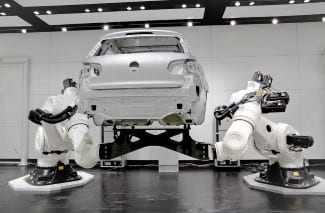Zero-Emission Vehicle Infrastructure Program (ZEVI): Funding for EV Charging Stations
The Zero-Emission Vehicle Infrastructure Program is providing applicants up to $5M to deploy a network of zero-emission vehicle charging and refuelling stations.

The Zero-Emission Vehicle Infrastructure Program is providing applicants up to $5M to deploy a network of zero-emission vehicle charging and refuelling stations.

The National Research Council (NRC) of Canada’s focus is to assist Canadian manufacturers in adapting to advanced manufacturing – including mass customization, process industrialization, and factory automation to increase the productivity and competitiveness of various sectors of Canadian industry. To address these opportunities for advancement, there is a high-tech space for Canadian SMEs to further…

While the transition to full autonomy will be gradual, technology developers and manufacturers need to be well ahead of consumer demand to push the technological readiness of autonomous vehicle systems. Constant research, development, and testing will help ensure that autonomous and connected vehicle technologies can be deployed once market and regulatory conditions support implementation. Having…

Few automotive trends require foresight into technology development, consumer preferences, and regulatory requirements like connected and autonomous vehicles. For C/AV technologies to reach mass market adoption, all three of these elements must align, with consumers and government regulators being confident in the technologies used. Without tested and proven high-quality systems, governments won’t let C/AVs on…

The automotive industry is preparing for a future where consumers can purchase a wide range of powertrain types. Although internal combustion engines (ICEs) will continue to represent a large portion of the market, battery electric and hybrid options will grow in popularity and become a much more widespread option. OEMs are preparing for this reality…

and autonomous vehicles are getting closer to being road-ready and manufacturers need to anticipate the shift. OEMs are doing a great job of phasing-in connected and autonomous vehicle technologies; this has made it easier for consumers and automotive suppliers to keep up. The implementation of new C/AV technologies in each model year is likely to…

Electric vehicle technology adoption must marry the readiness of manufacturers, consumers, and government regulators, all of whom have expressed varying levels of caution and optimism about the widescale adoption of EVs. There’s no one group that can independently bring electric vehicle technologies to the forefront; rather, it takes the collective and coordinated interest of all…

Ontario is on a mission to strengthen its position as a world-leading automotive manufacturer, by supporting its vast collection of information and communication technology companies. One of the key technologies emerging within the self-driving industry is high definition mapping for autonomous vehicles. HD maps are extremely high-resolution maps with centimetre-level precision to ensure the highest…